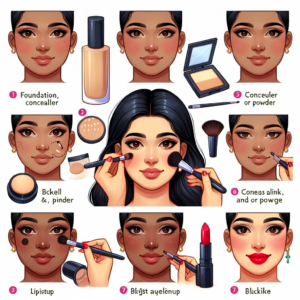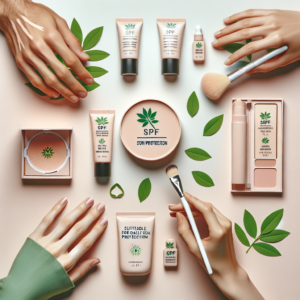
Key Takeaways
- SPF makeup protects your skin from harmful UV rays while enhancing your beauty.
- Choose SPF makeup based on your skin type and lifestyle for the best protection and performance.
- Natural ingredients can offer effective sun protection without harsh chemicals.
- Applying SPF makeup correctly ensures maximum protection and a flawless look.
- Keep your skin healthy by properly removing SPF makeup and adjusting your routine with the seasons.
Beauty By Earth’s SPF Makeup Favorites
When it comes to safeguarding your skin and boosting your confidence, SPF makeup is a game-changer. Beauty By Earth understands this and has curated a selection of SPF-infused products that not only protect your skin from the sun’s rays but also help you look and feel your best.
Top Picks for Face: From Foundations to Powders
Let’s start with the basics. A good SPF foundation is the cornerstone of any sun-safe makeup routine. Look for options like Beauty By Earth’s Tinted Facial Sunscreen, which comes in a range of shades to match your skin tone while providing broad-spectrum SPF 20 protection. For touch-ups or extra coverage, SPF powders are your best friend. They’re perfect for controlling shine and keeping your skin protected throughout the day.
Lip Balms and Glosses with SPF
Your lips need protection, too! SPF lip balms and glosses keep your lips hydrated and shielded from the sun. Opt for products with at least SPF 15, and reapply regularly, especially after eating or drinking.
Sunscreen Sprays and Creams for On-the-Go Protection
Sometimes, you need a quick and convenient way to reapply sunscreen throughout the day. That’s where sunscreen sprays and creams come in handy. They’re perfect for a fast application over makeup, so you never have to compromise on sun protection or beauty.
Why SPF Makeup is Your Beauty Secret Weapon
SPF makeup isn’t just about looking good; it’s about taking care of your skin’s health. With the right SPF makeup, you’re preventing signs of aging, reducing the risk of skin cancer, and keeping your skin looking youthful and radiant.
Defining SPF and Its Role in Makeup
SPF stands for Sun Protection Factor, and it measures how well a product will protect your skin from UVB rays, the kind that cause sunburn and contribute to skin cancer. By incorporating SPF into your makeup, you’re adding an extra layer of defense against these harmful effects.
The Importance of Daily Sun Protection
Even on cloudy days or when you’re indoors, UV rays can reach your skin. That’s why it’s crucial to wear SPF makeup daily. It acts as a shield, keeping your skin safe no matter where you are or what the weather is like.
Selecting the Right SPF Makeup for Your Skin
Choosing the best SPF makeup for your skin isn’t just about the level of protection—it’s about finding the right formula that complements your skin type and enhances your natural beauty. Whether you have oily, dry, or combination skin, there’s an SPF makeup product that’s perfect for you.
Understanding Skin Types
First, let’s identify your skin type. Oily skin types may prefer powder-based SPF products that help absorb excess oil. Dry skin types might lean towards SPF-infused tinted moisturizers that offer hydration along with protection. Combination skin types can benefit from a balanced SPF foundation that maintains skin’s moisture without adding too much shine.
Matching SPF Levels to Your Lifestyle
Your daily activities also dictate the level of SPF you need. If you spend most of your day indoors, an SPF of 15-20 may suffice. However, if you’re frequently outdoors or live in a sunny climate, aim for SPF 30 or higher to ensure your skin stays protected.

Ingredients Matter: What to Look for in SPF Makeup
When you’re browsing the beauty aisle, the list of ingredients in SPF makeup can be overwhelming. But here’s the inside scoop: look for products with skin-nourishing ingredients like hyaluronic acid, vitamin E, and zinc oxide. These ingredients not only protect your skin but also improve its overall health and appearance.
Natural vs. Chemical Sunscreens
The debate between natural and chemical sunscreens is ongoing, but here’s the bottom line: natural sunscreens, often labeled as “mineral,” use active ingredients like zinc oxide or titanium dioxide to physically block UV rays. Chemical sunscreens, on the other hand, absorb UV rays through a chemical reaction. Many prefer mineral sunscreens for their gentle nature, especially suitable for sensitive skin types.
Key Ingredients that Boost Skin Health
In addition to UV filters, SPF makeup can be packed with ingredients that promote skin health. Antioxidants like vitamin C fight free radicals, while natural oils like jojoba or coconut can hydrate and nourish. Look for these beneficial components to get the most out of your SPF makeup.
Application Tips for Flawless Coverage
Applying SPF makeup is an art that ensures you look fabulous and stay protected. Always start with a clean, moisturized face to create a smooth canvas for your makeup. Then, apply your SPF foundation evenly, using a makeup sponge or brush for a seamless finish.
Remember, SPF makeup is not just about the face. Extend the protection to your neck and ears for comprehensive coverage. And don’t forget to blend well along your jawline to avoid any telltale makeup lines.
For areas that need extra attention, like under the eyes or around the nose, use a concealer with SPF. This will not only conceal imperfections but also add an extra layer of sun protection.
- Start with a clean, moisturized face.
- Apply SPF foundation evenly with a sponge or brush.
- Extend protection to your neck and ears.
- Blend well to avoid harsh lines.
- Use an SPF concealer for extra coverage on targeted areas.
Step-by-Step Guide to Applying SPF Makeup
Here’s a quick guide to applying SPF makeup like a pro:
- Begin with a primer that has SPF to prepare your skin.
- Choose an SPF foundation that matches your skin tone and type.
- Apply with gentle, circular motions to ensure even coverage.
- Set your foundation with an SPF powder if needed, especially in oily areas.
- Finish with an SPF setting spray to lock in your makeup and add an extra layer of protection.
Reapplying SPF: Keeping Your Skin Protected All Day
Most importantly, remember that reapplying SPF is key to maintaining protection. If you’re out and about, carry a compact SPF powder for easy touch-ups. A setting spray with SPF can also refresh your makeup and boost your sun defense without messing up your look.
Maintaining Your SPF Makeup Routine
At the end of the day, removing your SPF makeup is just as important as applying it. Use a gentle makeup remover that can dissolve sunscreen without stripping your skin’s natural oils. Follow up with your regular skincare routine to ensure your skin stays healthy and clear.
As the seasons change, so should your SPF makeup routine. In the summer, you might need a higher SPF and oil-free formulas to combat the heat and humidity. In the winter, a more hydrating SPF makeup product will keep your skin from drying out in the cold air.
Effective Removal and Skin Care Post-Makeup
Always double-cleanse after wearing SPF makeup to thoroughly remove any residue. Start with an oil-based cleanser to break down the sunscreen, followed by a water-based cleanser to cleanse your skin. Finish with a moisturizer to restore hydration and repair your skin’s barrier overnight.
By following these tips and incorporating SPF makeup into your beauty routine, you’ll not only look your best but also keep your skin protected and healthy. Remember, beauty shines brightest when it’s safeguarded by the strength of SPF.
Reapplying SPF: Keeping Your Skin Protected All Day
To stay protected, it’s essential to reapply SPF makeup every two hours, especially if you’re spending time outdoors. But don’t worry, reapplication doesn’t mean you have to redo your entire face of makeup. There are smart and convenient ways to keep your skin safe without compromising on your look.
Carry a mineral SPF powder for quick touch-ups. This not only helps to mattify any shine but also reinforces your sun protection. If you’re using a liquid foundation, look for an SPF-infused setting spray that can be spritzed over makeup without disturbing it. And let’s not forget about the lips—keep an SPF lip balm handy to rehydrate and protect throughout the day.
Maintaining Your SPF Makeup Routine
Good habits are the foundation of skin health, and that includes a solid SPF makeup routine. Start each day by applying your favorite SPF makeup products, and end it by thoroughly removing them to keep your skin clear and ready for tomorrow.
Effective Removal and Skin Care Post-Makeup
After a day of looking fabulous and staying protected, it’s crucial to remove your SPF makeup properly. Use a dedicated makeup remover or cleansing oil to dissolve the sunscreen and makeup, followed by a gentle cleanser to wash away any remaining impurities. This two-step cleansing process, known as double cleansing, is key to maintaining healthy skin.
Once you’ve thoroughly cleansed your skin, follow up with a restorative night cream or serum. This not only helps to replenish moisture lost during the day but also supports your skin’s natural repair processes while you sleep. Remember, a nightly routine is just as important as your daytime one for keeping your skin at its best.
Adapting to Seasonal Changes and Skin Needs
Your skin’s needs can change with the seasons, and so should your SPF makeup routine. In the summer, you may need lighter formulations and higher SPF due to increased sun exposure. During winter, a more moisturizing SPF product can help combat dry, chapped skin. Pay attention to how your skin reacts as the weather changes, and adjust your products accordingly to maintain balance and protection.
Frequently Asked Questions
Can You Rely on SPF Makeup for Full Sun Protection?
While SPF makeup is a great addition to your sun protection arsenal, it should not be your only line of defense. For full sun protection, use a broad-spectrum sunscreen under your makeup, and consider wearing protective clothing and seeking shade during peak sun hours.
How Often Should You Reapply SPF Makeup?
As a rule of thumb, reapply SPF makeup every two hours, or more frequently if you’re sweating or swimming. Keep in mind that SPF in makeup might not be as concentrated as in sunscreen, so be diligent about reapplication.
What SPF Rating is Recommended for Daily Makeup Wear?
For daily wear, an SPF rating of at least 15 is recommended, but SPF 30 or higher is ideal, especially if you’ll be spending extended periods outdoors.
Are There SPF Makeup Options for Sensitive Skin?
Yes, there are SPF makeup options formulated for sensitive skin. Look for products labeled “fragrance-free” and “non-comedogenic,” and choose mineral-based sunscreens that are less likely to irritate sensitive skin.
How Can You Tell if SPF Makeup is Expired?
SPF makeup, like all sunscreens, has an expiration date. Check the packaging for this date and note any changes in texture, color, or smell of the product. If in doubt, it’s safest to replace it to ensure effective protection.
By integrating SPF makeup into your daily beauty routine, you’ll not only enhance your natural beauty but also protect your skin’s health. Remember, true beauty confidence comes from taking care of yourself, inside and out. So embrace SPF makeup as a daily habit, and your skin will thank you for years to come.




